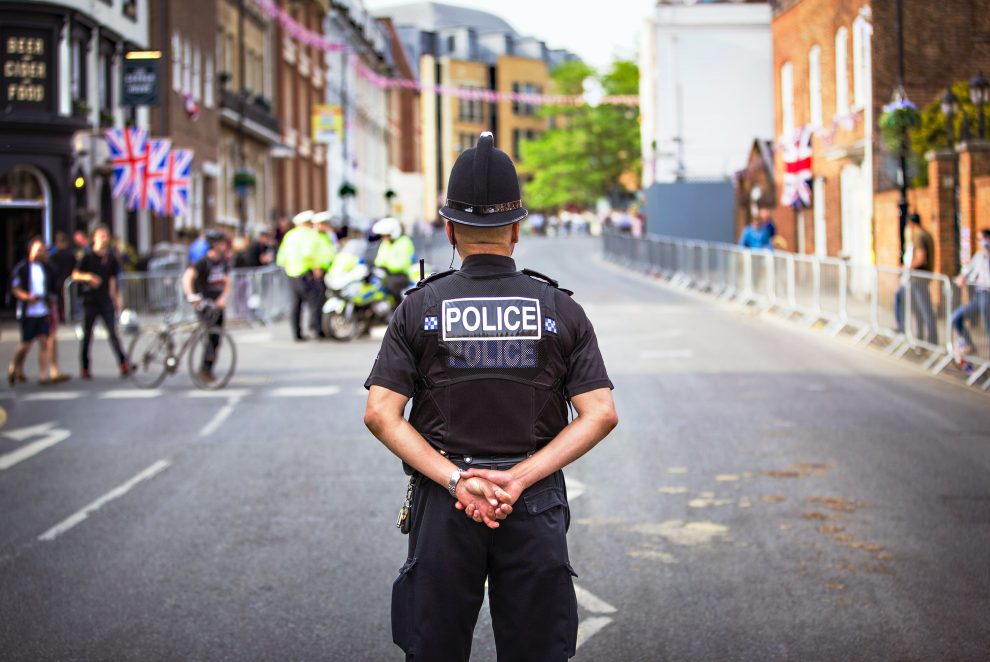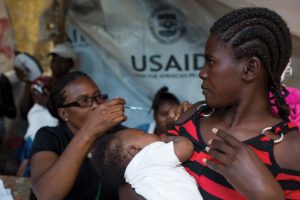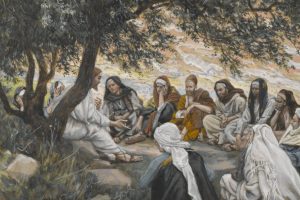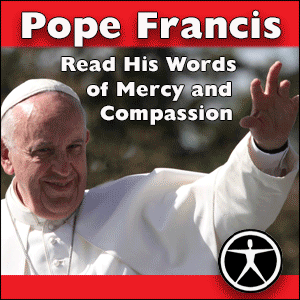Tobias Winright’s first exposure to the life of a police officer came from a somewhat unlikely source: his mother. After his parents divorced when he was 10 years old, Winright moved to Florida with his three younger brothers and their mother, who took a job as a patrol officer. She worked her way up the ranks, serving as a hostage negotiator and homicide detective, once earning second place honors as deputy sheriff of the year for the entire state of Florida.
When Winright needed a job to work his way through college, law enforcement seemed like a natural choice. He was hired by the same department where his mother and step-father worked. He was also assigned as a corrections officer to the maximum security jail.
As a cradle Catholic, Winright often grappled with ethical questions about the use of force while in the line of duty. “When I wore a badge, I asked myself, would I really shoot someone to kill him?” he recalls. “That question really occupied me.”
As a theologian and ethicist, Winright has continued to pursue questions about force and violence; he has also taught ethics at police academies. His personal background and real-life experience give him a unique insight into the challenges of policing. “My experience, even though it is not a lot, has gotten me a lot of mileage—even with police officers,” he says.
What was your outlook on policing when you started working in law enforcement?
When I was 19 and interviewing for jobs, I said all the standard things: I grew up reading Spiderman and Captain America and I wanted to make a difference in my community. I wanted to give back. I wanted to serve and protect.
I saw it as a civic duty, and I think a lot of people start off with this motivation. But there’s a culture today among police that has gotten such a strong footing. Immediately out of the academy, people on the force will tell you, “Forget everything you learned in the academy. It’s different out here.” There is that mentality of a much more cynical “us versus them” attitude between police and the community.
Where do you think that attitude comes from?
Policing is a hard job. It is often a thankless job. Divorce rates and suicide rates are high among police. It is a very difficult job, and it can be very dangerous.
But policing doesn’t have to be what it has evolved into. It will still be dangerous at times and yes, it may still require the use of force. But that shouldn’t be what policing is all about. That is an instrument; it is not the essence of policing.
How has policing evolved into what it is today?
One of the reasons policing has not really been addressed in the Christian theological tradition is it’s a recent institution. Policing as we know it started in 1829 with Robert Peel, who inspired the “bobbies” in London. His vision was for police to be citizens, not soldiers.
He wanted them to wear a blue uniform, not red uniforms. He wanted them to be in and of the people, not an occupying force against the people. He wanted them to be in the community as a positive force that might actually prevent crime from happening, rather than reacting to crime and exacerbating things.
Prior to Peel, you had sheriffs and constables. Going back further, in Roman times, the military used to do policing. The function had already been there, but Peel wanted something institutionalized that would be more effective, and also more communal.
That model, what we would call community policing today, was transported to the United States and used at first in New York, Boston, and Philadelphia. That was how things were done for decades and, in fact, it still is the case in some countries. I was just in England last fall, and the terror alert was at the second highest level. I was walking around, and I couldn’t believe that I was still seeing unarmed police. It wasn’t like how it would be here.
I knew that they had things at the ready if necessary, and people do worry that the militarization and the arming of the police is happening there, too. Still, it is noticeably different than in the United States.
What caused that change in the United States?
What happened here was that the community policing model really took hold in the Northeast. In the South, however, policing had its origins in the slave patrols. There, you already had an element of race built into policing as it developed in some states.
In places like Missouri, where settlers came from both the North and South, there was a competition between the two models to determine which one was going to take hold. There wasn’t one uniform view of policing in the United States at the time.
After the Civil War we had a surplus of weapons. It was sort of like what is happening now after Iraq and Afghanistan, with cities getting armored vehicles and weapons from the military. Police started arming themselves with these weapons that were suddenly available, even though it wasn’t required. It didn’t become an expectation or a requirement that police be armed until the early 20th century—especially during the gangster era of the 1920s, when people like Al Capone and John Dillinger started having machine guns.
That’s also when police started riding in cars instead of being on the beat. That’s when they started having better and better weapons. That’s when the idea of militarized policing—that it is more about fighting crime than service to the community—started to get traction.
How did that model of policing become so prevalent?
Radley Balko wrote a book, The Rise of the Warrior Cop (PublicAffairs), which really gives a nice history of the militarization of the police, especially in the last few decades. Really it began in the ’70s under Richard Nixon when the country started using war language—the war on crime, the war on drugs. As Balko documents, the more such language was used, the more demonstrators and people of color started being referred to in very dehumanizing terms.
At the same time, you also had the rise of SWAT (Special Weapons and Tactics). When I was a little kid, I watched police shows like Adam-12. Then, in 1975, there was a new show that was all the rage called S.W.A.T. after Los Angeles started the SWAT team in 1974.
Initially, SWAT was meant to deal with extreme situations like the 1966 clock tower shooting at the University of Texas. Police, with their regular equipment, were unable to stop the shooter. SWAT was meant to be a special group that could respond to a situation like that, or to something like the recent shootings in Paris. But towns with as few as 10,000 people have SWAT teams now.
The vast majority of what SWAT teams are doing now, though, is related to drug crimes. Most of it isn’t life threatening. It isn’t even violent crime. This model of policing is about fighting crime, being armed, and getting criminals. That has become the dominant model.
While I was in Iowa teaching at Simpson College, 12 miles south of Des Moines, the Des Moines Police Department asked me to teach ethics at their academy and in-service training. I also served as a reserve police officer patrolling the city whenever I had free time from teaching at the college.
For the recruits there, this model of policing is what got their adrenaline going. They’d say, “I can’t wait until we go into the dark building and have to find somebody who is hiding.”
It does get one’s adrenaline going. I feel it now just talking about it. But studies show that 70 to 90 percent of what you do when you’re a police officer isn’t about that. It is being the first one on the scene at a car accident, performing CPR, or directing traffic. It’s all these other things that aren’t highlighted.
But when you see the police in a parade, what are they showing off? Their latest armored vehicle. That is not sending the message that if police and the community work together they can make a positive difference.
Don’t high levels of crime, at least in some areas, force police to become more militarized?
I think that’s a part of it, too. I wouldn’t say it is a chicken and the egg thing. Maybe it is a little bit of both. But I do think the model is important.
A lot of police departments will even emphasize community policing in their mission statements, but there are different versions of what community policing looks like, even now. There’s been the “broken windows” approach (based on the theory proposed by social scientists James Wilson and George Kelling) that emphasizes addressing minor crimes like vandalism. People are complaining about this in New York now because police are giving people tickets for things that are not really even crimes. That’s not really community policing, either.
The Justice Department has a program called COPS (Community Oriented Policing Services). There have been police departments who have received grants from that but end up using the money to get military equipment. So the idea of “community policing” has been co-opted a bit. We have to be more careful about what that term means.
So ideally, what does community policing look like?
First of all it is a philosophy, an attitude to serve and protect. When Adam was in the garden, Genesis says he was to till and keep the garden. Some biblical scholars say the best translation of “till and keep” in Hebrew would be “serve and protect.” That’s what’s painted on our police cars.
We’re not supposed to dominate and be adversarial. We are meant to be stewards of one another. I think back to Genesis, when God asked Cain where Abel was and Cain said, “Am I my brother’s keeper?” As Catholics we say, “Yes, we are each other’s keepers.”
And community policing, from a Catholic perspective, would be like that. We just need an attitude adjustment.
Community policing is about being more proactive than reactive, taking a more preventive and problem-oriented approach to crime. Police and citizens share a stake in the common good and welfare of their communities.
What changes can police make to achieve that ideal?
Community policing is a partnership. It encourages police to purchase homes in the neighborhoods where they work. They’d have substations in different neighborhoods instead of one headquarters. Police officers also are encouraged to become involved in community activities, such as coaching sports teams.
Police departments would prioritize hiring recruits who have an understanding of the diverse communities they will serve. And the police get out of their cars—they get to know, listen to, and interact face-to-face with citizens.
There will still need to be some cars. But try to have more police on bicycles. Have more police walking beats. Police used to know people in the neighborhood by name. Some still do, but how many of us really know, especially in our larger cities, the police by name? That car driving down the street with the window rolled up makes a difference. It really does.
At the same time, community residents have a role to play in peacekeeping and crime prevention. Through neighborhood watch programs, safe houses, and other community service organizations, citizens share responsibility with police for the quality of life and common good of their community.
There are some other views that say, “Police? That’s about the arm of the state. Its function is just to protect and use force.” That’s more of a negative, minimalist view. Catholic social teaching has a more positive view about the common good, about government as more than just something that protects us.
As a Catholic, I want to understand police in a way that’s consistent with our understanding of government and politics itself. That would mean policing has these more positive aspects to it, rather than only a crime-fighting function.
Do you ever hear feedback from police about your views on this?
Yes, in fact I just recently got an email from someone out of the blue. This person had seen the statement I coauthored on racial justice and said, “Why don’t all you theologians worry more about capturing criminals and stopping them from committing crimes?” I wrote back just one line: “Well, I used to do that when I wore a badge.”
But yes, somebody might read my work and say, “Oh, these are theologians and all they do is ask how many angels fit on a pin head and all that.” Not everybody is going to take the time to go and read about what I’ve done.
I have friends who are county and city police officers in St. Louis, and they agree with much that I’ve written with regard to models of policing. In fact, one such police officer is in our master’s program at SLU right now. He had seen some of my work and told me that it resonates with his experiences and thoughts about how policing ought to be done.
How might police start working toward that in the wake of events like what happened in Ferguson?
Trust has broken down, and I think we just have to start where we’re at.
The principle of subsidiarity means all levels have their role to play. I’m glad the Justice Department is calling for police reform at the federal level, but I wouldn’t want that to be the only egg in our basket. We need to do things at the state level, at the community level, and in our cities.
Cincinnati is a wonderful example. They had incidents several years ago like what has happened in Ferguson, and now their department has changed to a community policing model.
San Diego is another example. After the Rodney King beating in the early ’90s, there were riots in L.A. and in other California cities, but not in San Diego. They had community policing. The communities of color there didn’t worry about the police coming in as an occupying force. The police were already there. They were part of the community.
I went to Nicaragua several years ago. They had a revolution; they’ve had a lot of violence. But now policing there is more of a community-oriented model. Gangs aren’t a problem. Crime is not like it is in other places in Latin America that have more militarized policing.
I think it’s pretty evident that community policing is the way to go. When you look at these examples and do a cost-benefit analysis, there’s empirical evidence that this model is really effective.
It is in the best interests of police as well. This needs to be taught at academies and in their training after the academy.
I think policing jobs will actually be less dangerous if they’re not so militaristic. If police are less adversarial at the outset, there are many ways that a community model can diffuse things, unlike what happened in Ferguson.
Living in St. Louis, you were very close to Ferguson. How has it impacted your community?
My wife and I were getting ready for bed that first night when I saw on TV the armored vehicle with a fellow up there with a rifle aimed at people. I looked at my wife and said, “This is not going to go well.” I just knew that it was going to be a catalyst for making things worse, rather than making things better.
But it has sparked discussion. I’ve done a talk on this in my parish and elsewhere, locally and beyond. It’s a topic in many university classrooms—not only in St. Louis but all around the country. There should also be, I think, a national summit.
I feel this has been such a blind spot for theology, even though there has been more interest in it over the last decade or so. But we need to talk about these issues all the time. This is something that’s right here in our communities. It’s so close to us that we’ve missed it. We have visual agnosia, not seeing what’s right in front of us.
But we have to be careful not to mirror the “us versus them” mentality back at the police. The police are us, too. They’re in our pews.
As theologians, it is important for us to emphasize that everyone is made in the image of God. We’re all part of this community together. How can we go forward in a way that promotes the common good? I really do believe that it would be best for police, for communities of color, and for us as a nation to work together on these issues.
How do you think some of the recent criticism of policing has affected police?
We all get defensive when we’re under criticism. When I get my course evaluations, 98 percent of them can be positive. Two percent could be criticism of one thing I did that semester, and that’s all I’m going to dwell on. I understand that.
For police, part of the job requirement is that you have a thick skin. As an officer, I’ve had feces thrown at me. I’ve had harsh words thrown at me, too. I understand this feeling of defensiveness.
I do think that some of the demonstrations have been adversarial toward the police instead of trying to engage with them.
What role should the church play in promoting that kind of dialogue?
The bishops over the decades have issued some good statements on race and criminal justice in which they reference connections between the two. But it’s been at least 10 years since they’ve issued a major statement on either one.
It is probably time for a new document. Wouldn’t it be wonderful if we could have another statement from the bishops like “Economic Justice For All” or “The Challenge of Peace”—a statement that included input from laypeople, from theologians, from bishops, from police, from people of color?
It’s hard to say where to start and what to do, but it has to happen at all levels. What can we do as a church to exemplify this and model it, to where we can bring people together to talk and to go forward together? That’s our role.
What can individuals and parishes do in their communities?
Bishop Edward Braxton (of Belleville, Illinois) issued a message on the racial divide in the United States for the World Day of Peace this year, and I think he had some good suggestions. His message was very balanced and well-informed.
One suggestion he had is that parishes partner up with another parish. Maybe, I would even add, partner up with another Christian denomination. If there’s not another Catholic parish that is racially diverse, there’s got to be a Methodist or Episcopal church in town.
Partner up and do something together. Worship together, get to know each other. Segregation is back in new ways. There are so many people who don’t encounter the other.
I live in a neighborhood where another shooting occurred last fall near our parish. My family and I intentionally moved there. People on our street are Asian, Hispanic, black, and from the Middle East, and some of this diversity is present in our parish. We wanted our two daughters to grow up and pray and worship where not everyone looks like us.
That is probably not the experience of too many Catholics. We belong to a church that transcends national borders. It should also transcend those borders we have created or inherited right here within our cities that tend to segregate us.
Catholics are about peace, justice, and reconciliation. We’re about restorative justice. That model has been talked about a lot with regard to prisons. I think it also needs to be a part of policing.
We love God because God first loved us, and we’re called to be a church. We need to take the initiative. We can’t expect the police to do it. We can’t expect demonstrators to do it.
We as a church are supposed to be a sacrament to the world, a community of all communities. What can we do to facilitate, to encourage, to be a catalyst for bringing these groups together? One suggestion that has been talked about is a truth in reconciliation commission or something to that effect, which is something that happened in South Africa. There was also one in Greensboro, North Carolina a number of years ago.
Who’s going to really step up and make something like that happen? Maybe it’s us.
This interview originally appeared in the April 2015 issue of U.S. Catholic (Vol. 80, No. 4, pages 18–22). It received an Award of Merit at the 2016 Associated Church Press awards.
Image: Unsplash/KingsChurchInternational















Add comment